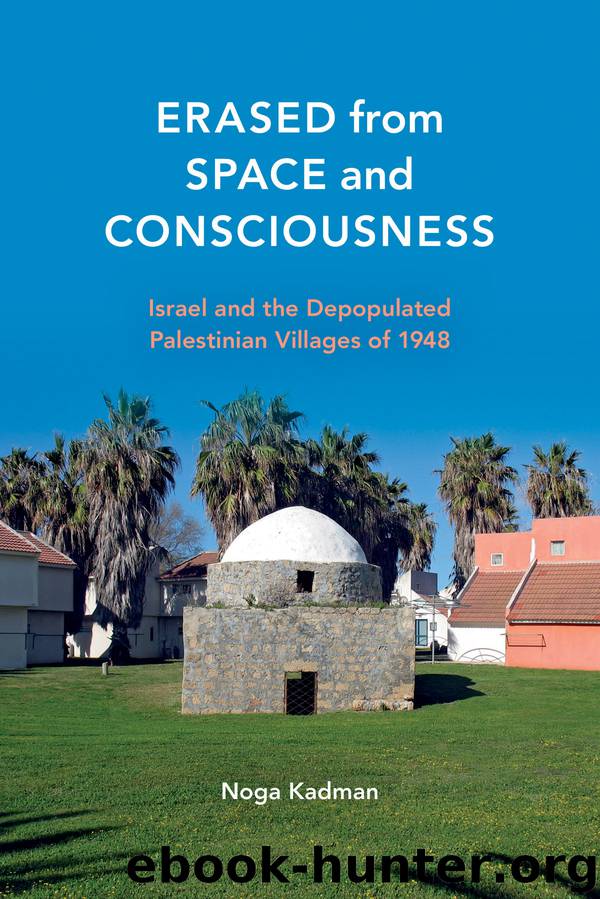Erased from Space and Consciousness by Noga Kadman Oren Yiftachel

Author:Noga Kadman, Oren Yiftachel
Language: eng
Format: epub
Published: 2019-01-24T16:00:00+00:00
The Dispossession of the Palestinian Refugees
We tend to regard all of the abandoned property as property of the State of Israel, with which the State of Israel can do as it wishes.
—Foreign Minister Moshe Shertok at the Knesset
(the Israeli Parliament), May 2, 1949 (Benziman and Mansour, Subtenants)
The Palestinian refugees left their homes and their lands on the assumption they would be able to return after the fighting was over. As such a return was never allowed; they lost nearly everything they had—lands, orchards, homes, and personal property. Beyond possessions, the refugees lost the stable, familiar lives they had led and the communal-economic web in which they had dwelled.
There is a wide range of estimates of the material property left by the refugees in the wake of their flight. Atif Kubursi, who investigated the matter and examined the different estimates, concludes that the lost Palestinian property amounted to 743,000,000 pounds sterling. 33 In 1951 the Israeli foreign minister, Moshe Shertok, estimated the total worth of the refugee property at one billion U.S. dollars. 34
In 1948 the Palestinians lost most of the land they owned. In 1947, only 7 percent of Mandate-era Palestine (some 440,000 acres) was owned by Jews, whether publicly or privately. 35 After the war, Israel held a general territory of over five million acres, of which less than nine hundred thousand acres (17 percent) were Jewish-owned land and state land handed over by the Mandate government. 36 Nearly all the rest were lands left behind by Palestinian refugees, mostly in the Negev. The Israeli Ministry of Agriculture estimated in 1949 that refugee-owned lands amounted to 80 percent, or 4.1 million acres of the territory of the entire state. 37 Later estimates were more modest, as they excluded Negev lands where Bedouins had used to live: an Israeli survey estimated the lands of the absentees at just over one million acres. 38 Summing up Khalidi’s data on the precise territory of every village and its land brings the total up to a similar number—smaller by some twelve thousand acres. 39 Abu Sitta suggests that the land of the Bedouin refugees of the Negev—absent from Khalidi’s count—amounts to some three million acres. 40 In 1962, the Israeli Justice Ministry estimated the worth of the refugee land at over 140,000,000 pounds sterling. 41
Palestinian refugees also left their homes in eleven cities—six of these Arab, and five mixed Arab-Jewish. Vast parts of ninety-four other towns that continued to exist after the war were also emptied of their Arab residents. 42 Estimates of the overall number of depopulated Palestinian communities range between 356 (Kimmerling) and 531 (Abu Sitta). 43 Abu Sitta includes in his count residency sites of Bedouin tribes, mostly in the Be’er Sheva governorate, whose population, he asserts, amounted in 1948 to ninety thousand—the equivalent of 125 average-sized villages. 44 Throughout this book I use Walid Khalidi’s list of 418 depopulated villages.
The real estate assets left behind by Palestinian refugees included houses, schools, clinics, mosques, and churches, and in the cities also commercial centers, banks, hospitals, and public parks.
Download
This site does not store any files on its server. We only index and link to content provided by other sites. Please contact the content providers to delete copyright contents if any and email us, we'll remove relevant links or contents immediately.
Cecilia; Or, Memoirs of an Heiress — Volume 1 by Fanny Burney(31333)
Cecilia; Or, Memoirs of an Heiress — Volume 3 by Fanny Burney(30934)
Cecilia; Or, Memoirs of an Heiress — Volume 2 by Fanny Burney(30889)
The Great Music City by Andrea Baker(21318)
We're Going to Need More Wine by Gabrielle Union(18074)
Bombshells: Glamour Girls of a Lifetime by Sullivan Steve(13109)
Pimp by Iceberg Slim(12932)
All the Missing Girls by Megan Miranda(12752)
Fifty Shades Freed by E L James(12451)
Norse Mythology by Gaiman Neil(11883)
Talking to Strangers by Malcolm Gladwell(11879)
Crazy Rich Asians by Kevin Kwan(8351)
Mindhunter: Inside the FBI's Elite Serial Crime Unit by John E. Douglas & Mark Olshaker(7834)
The Lost Art of Listening by Michael P. Nichols(6474)
Enlightenment Now: The Case for Reason, Science, Humanism, and Progress by Steven Pinker(6406)
Bad Blood by John Carreyrou(5770)
The Four Agreements by Don Miguel Ruiz(5511)
Weapons of Math Destruction by Cathy O'Neil(5038)
We Need to Talk by Celeste Headlee(4870)
